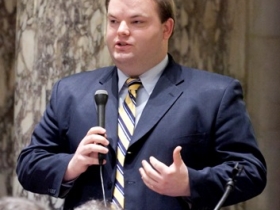Why the Huge Support for Shot Spotters?
Legislature votes 132-1 to expand Milwaukee program monitoring gunshots.
Next to his desk in a fourth-floor Capitol office, Democratic Rep. Evan Goyke keeps a map dotted with the location of every shooting in his 18th Assembly District. Goyke gets new totals every year for his neighborhoods from the Milwaukee Police Department.
The department’s 2013 totals for Assembly District 18: 1,258 shootings or “shots fired” reports (a one-year increase of 9 percent), 110 non-fatal shootings, and nine deaths involving firearms (of the total 16 murders in the district).
Those numbers, and his experiences as a former public defender, are why Goyke and every legislator but one voted to have all state taxpayers pay half of the $350,000 cost to expand the ShotSpotter program from 3.5 to 10 square miles of the city.
Milwaukee Police Chief Ed Flynn says ShotSpotter can send officers to within 11 feet of where shots were fired. ShotSpotter gives his officers information, intelligence and evidence “we could only dream of in the past,” Flynn said in a WisconsinEye interview. “It’s been a profound tool for us in arrests, prosecutions and deployments.”
A 2011 study found that residents in some Milwaukee neighborhoods were so used to hearing gunshots that they only called police to report 14 percent of those incidents, Flynn noted. Those neighborhoods, he added, are “the domestic version of Baghdad – that’s intolerable.”
Goyke says expanding ShotSpotter “will make crime detection much better.”
Last week, the state Senate took less than two minutes – or about one second for each of Milwaukee’s 105 homicide victims in 2013 – to send Gov. Scott Walker the bill spending $175,000 to expand ShotSpotter. The Senate vote was unanimous. Weeks earlier, the Assembly voted 95-1 for the bill; the only no vote came from Republican Rep. Tyler August.
Milwaukee’s two African-American senators endorse ShotSpotter. “Expanding coverage from 3 to 10 square miles is a necessary step when the Milwaukee Homicide Review Commission reported that the homicide rate in Milwaukee increased by 15 percent in 2013, and 77 percent of those homicide involved firearms,” said Sen. Lena Taylor. “Speed and precision are our greatest advantage in protecting public safety, and for that ShotSpotter has proven to be a powerful ally.”
ShotSpotter is “making our community a better place to live,” said Sen. Nikiya Harris. “As a community, it is important to invest in new technologies that will advance our capabilities to respond to and eventually prevent horrifying acts of violence,” Harris added. “I cannot imagine the heartbreak of losing a child, as many in my district have.”
Milwaukee County has already approved $175,000 to match the state government’s cash. And, Democratic Rep. JoCasta Zamarripa said she will continue lobbying Flynn to expand ShotSpotter into Milwaukee’s near South Side, which she represents. While the number of gunshots in that area may not be as high as in other areas of Milwaukee, Zamarripa said, “We want to cut it off at the pass.”
Other Wisconsin cities don’t have enough firearm deaths to justify ShotSpotter.
Madison had five homicides last year, but guns were involved in only two of them, said Police spokesman Joel DeSpain. Madison “doesn’t have that many shots fired in a specific region that it would make sense” to pay for ShotSpotter, DeSpain said. “Criminals who have guns are pretty mobile.”
Green Bay and Beloit had three homicides each, although one Beloit shooting death was an officer-involved shooting later ruled as justified. Janesville had no homicides last year.
But one African-American leader in Milwaukee, Clayborn Benson, executive director of the Wisconsin Black Historical Society, said ShotSpotter amounts to “the continued invasion of our community….If that made our streets safer, then I’m for that. But I’m not convinced that it does.”
African-American residents who live in ShotSpotter neighborhoods are already under “great stress” from a lack of jobs, economic uncertainties and fear – and monitors that record gunshots and other noises near their homes contribute to that trauma, Benson said.
“There’s no difference between listening and cameras.”
Steven Walters is a senior producer for the nonprofit public affairs channel WisconsinEye. Email stevenscwalters@gmail.com
Political Contributions Tracker
Displaying political contributions between people mentioned in this story. Learn more.
- December 31, 2019 - JoCasta Zamarripa received $50 from Nikiya Dodd
The State of Politics
-
RNC Brings Fame to Gen Z Party Leader
 Jul 15th, 2024 by Steven Walters
Jul 15th, 2024 by Steven Walters
-
Wisconsin’s Republican Roots Run Deep
 Jul 8th, 2024 by Steven Walters
Jul 8th, 2024 by Steven Walters
-
Feuding Supreme Court Justices Need a Break
 Jul 1st, 2024 by Steven Walters
Jul 1st, 2024 by Steven Walters
























But one African-American leader in Milwaukee, Clayborn Benson, executive director of the Wisconsin Black Historical Society, said ShotSpotter amounts to “THE CONTINUED INVASION OF OUR COMMUNITY….If that made our streets safer, then I’m for that. But I’m not convinced that it does.”
African-American residents who live in ShotSpotter neighborhoods are already under “great stress” from a lack of jobs, economic uncertainties and fear – and monitors that record gunshots and other noises near their homes contribute to that trauma,” Benson said.
How can someone who truely cares about their neighborhood say something like this? The invasion isn’t from Shot Spotter…the neighborhood has been invaded by violent criminals.
Why no details on the one “no” vote? Surely some argument was made; we’d like to hear the other side…no matter how small.